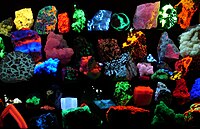
Photo from wikipedia
Combination of fluorescence excitation-emission matrix spectroscopy with parallel factor analysis (PARAFAC) and principal component analysis (PCA) was engaged to track fluorescent components of dissolved organic matter (DOM) extracted from soils,… Click to show full abstract
Combination of fluorescence excitation-emission matrix spectroscopy with parallel factor analysis (PARAFAC) and principal component analysis (PCA) was engaged to track fluorescent components of dissolved organic matter (DOM) extracted from soils, to seek potential factors, and to reveal their correlations with physico-chemical properties of soils. Soil samples at different depths were collected in Hetao irrigated area of Inner Mongolia, China. Five fluorescent components (C1 to C5) were identified by PARAFAC modeling of DOM extracted from the soil samples. C1 was referred as fulvic-like fluorescent component, by which DOM was dominated in the whole soil samples. C2 was associated with salinity and agriculture, which was similar to marine humic-like fluorescent component. C3 was assigned as traditional humic-like fluorescent component. The three components were of the terrestrial origin. C4 was involved in tryptophan-like fluorescent component, which was autochthonous productions of biological degradation. C5 might be a polycyclic aromatic hydrocarbon contaminant, which could be relative to anthropogenic sources of pesticides. The C1, C2, and C3 were the potential factors of characterizing DOM fractions using PCA on fluorescent components and physico-chemical parameters. Moreover, DOM might restrained by exchangeable sodium percentage, and its formation and decomposition might be influenced by soil moisture.
Journal Title: Environmental Science and Pollution Research
Year Published: 2017
Link to full text (if available)
Share on Social Media: Sign Up to like & get
recommendations!